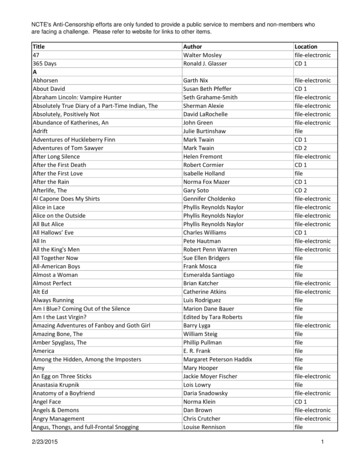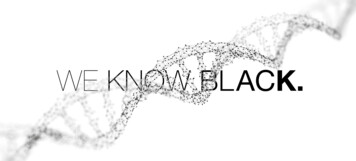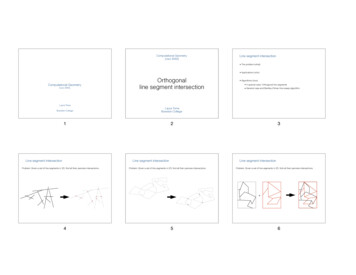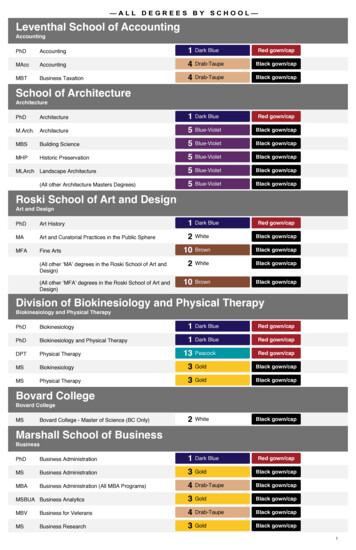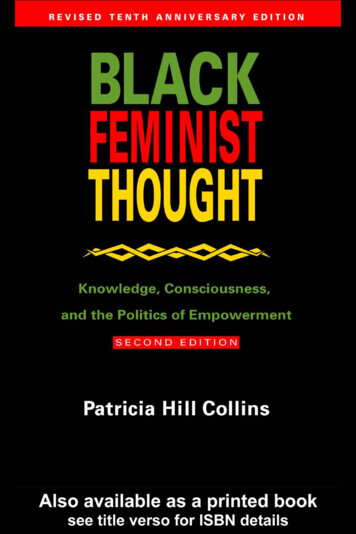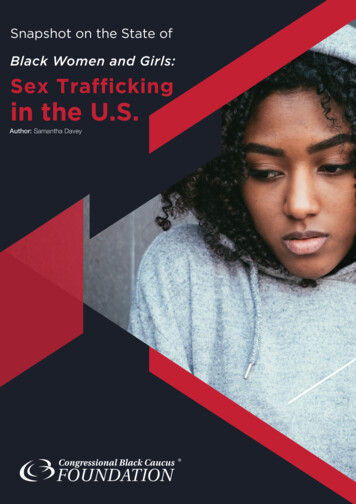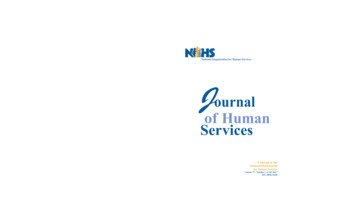
Transcription
National Organization for Human ServicesNational Organization for Human ServicesJournal of Human Services Volume 37, Number 1 Fall 2017JournalournalJJournalof HumanofHumanServicesof HumanServicesServicesA Journal of theNational Organizationfor Human ServicesA Journal of theNational Organizationfor HumanA Journalof the ServicesVolume 34, OrganizationNumber 1 Fall 2014NationalISSN 0890-5428for Human ServicesVolume 37, Number 1 Fall 2017ISSN 0890-5428Volume 34, Number 1 Fall 2014ISSN 0890-542865080 NOHS covers nk.indd 19/16/2017 8:42:54 AMCOVER 4COVER 1CYAN MAGENTA YELLOW BLACKNational Organization for Human Services
Journal of Human ServicesFall/2017National Organization for Human ServicesThe National Organization for Human Services (NOHS) was founded in 1975 as anoutgrowth of a perceived need by professional care providers and legislators forimproved methods of human service delivery. With the support of the National Instituteof Mental Health and the Southern Regional Education Board, NOHS focused itsenergies on developing and strengthening human service education programs at theassociate, bachelor’s, master’s, and doctoral levels.The current mission of NOHS is to strengthen the community of human services by: (a)expanding professional development opportunities, (b) promoting professional andorganizational identity through certification, (c) enhancing internal and externalcommunications, (d) advocating and implementing a social policy and agenda, and(e) nurturing the financial sustainability and growth of the organization.Members of NOHS are drawn from diverse educational and professional backgroundsthat include corrections, mental health, childcare agencies, social services, humanresource management, gerontology, developmental disabilities, addictions, recreation,education, and more. Membership is open to human service educators, students,fieldwork supervisors, direct care professionals, and administrators. Benefits ofmembership include subscriptions to the Journal of Human Services and to the Link (thequarterly newsletter), access to exclusive online resources, and the availability ofprofessional development workshops, professional development and research grants, andan annual conference.Six regional organizations are affiliated with NOHS and provide additional benefits totheir members. They are the New England Organization for Human Service, MidAtlantic Consortium for Human Services, Southern Organization for Human Services,Midwest Organization for Human Services, Northwest Human Services Association, andWestern Region of Human Service Professionals.NOHS is closely allied with the Council for Standards in Human Service Education(CSHSE). CSHSE, founded in 1979, has developed a highly respected set of standardsfor professional human service education programs and also provides technicalassistance to programs seeking Council accreditation.Membership information can be found on the NOHS website by clicking “Join Now”at: www.nationalhumanservices.org. Correspondence about membership can be foundat http://www.nationalhumanservices.org/membership.1
Journal of Human ServicesFall/20172017 Editorial BoardNational Organization for Human ServicesLead EditorsEd Neukrug & Tammi Milliken, Old Dominion University, Department of Counseling and Human ServicesKevin Snow, Texas A&M University-Commerce, Department of Psychology, Counseling, and Special EducationAssistant EditorSandy-Ann M. GriffithOld Dominion University, Department of Counseling and Human ServicesCopy EditorKristina NeukrugReviewersRebecca CowanCappella UniversityHarold Abel School of Social andBehavioral SciencesMike KalkbrennerNew Mexico State UniversityDepartment of Counseling and Educational PsychologyLaurie CraigenBoston UniversitySchool of MedicineMental Health Counseling andBehavioral Medicine ProgramGreg HickmanWalden UniversitySchool of Human ServicesCheree HammondEastern Mennonite UniversityMaster of Arts in Counseling ProgramSandra HaynesMetropolitan State Collegeof DenverCollege of Professional StudiesFrederick SweitzerUniversity of HartfordInterim ProvostChaniece WinfieldOld Dominion UniversityDepartment of Counseling and HumanServicesSherrilyn BernierGoodwin CollegeDepartment of Social and EducationalSciencesMargaret SabiaWalden UniversitySchool of Human ServicesMia SwanOld Dominion UniversityDepartment of Counseling andHuman ServicesDonald Froyd, Jr.New Mexico Highlands UniversityDepartment of Social WorkDepartment of CounselingKathleen LevingstonWalden UniversityClinical Mental Health CounselingShawn RicksOld Dominion UniversityDepartment of Counseling andHuman ServicesMark RehfussOld Dominion UniversityDepartment of Counseling andHuman ServicesPage 2
Journal of Human ServicesFall/2017Table of ContentsResearch Articles Human Service Students’ and Professionals’ Knowledge and Experiences ofInterprofessionalism: Implications for Education Kaprea F. Johnson, Narketta Sparkman-Key, Michael T. Kalkbrennerpp. 5-13 Taking Deliberate Steps: Working Toward a Career in Human Services inAppalachia Amber N. Hughes, Megan Herscher, Blair Mynattpp. 15-26 Barriers to Counseling among Human Service Professionals: The Development andFit, Stigma, & Value (FSV) Scale Edward S. Neukrug, Michael T. Kalkbrenner, Sandy-Ann M. Griffithpp. 27-40 Human Services Students’ Preferences for Master’s Level Training Tammi F. Dice, Mark C. Rehfusspp. 41-53Conceptual Articles Professional Standards: Embracing Preventive Ethics in Human Services Chaniece Winfield, Narketta Sparkman-Key, Anthony Vajdapp. 55-62 Identify, Intervene, and Advocate: Human Services Workers’ Role in YouthSex Trafficking Amanda J. Rockinson-Szapkiw, Lucinda S. Spaulding, Judith M. Spieth Justice,Delila Owenspp. 63-76Brief Reports Human Services Professionals and the Ongoing Need for Aging-Related Education Melanie H. Mallers, James R. Rubypp. 77-80Book Reviews Review of Deliberate Practice for Psychotherapists: A Guide to Improving ClinicalEffectiveness John Paulsonpp. 81-82 Review of Neurotribes: The Legacy of Autism and the Future of Neurodiversity Shoshana D. Kerewskypp. 83-84Guidelines for Authorspp. 85-86Page 3
Journal of Human ServicesFall/2017Page 4
Journal of Human ServicesFall/2017Human Service Students’ and Professionals’ Knowledge andExperiences of Interprofessionalism: Implications for EducationKaprea F. Johnson, Narketta Sparkman-Key, Michael T. KalkbrennerAbstractInterprofessionalism is an approach to delivering optimal client care in which providers frommultiple professions work collaboratively on care teams. Human Service Professionals (HSPs)are generalists who frequently work together with professionals in related fields. The purpose ofthis study was to investigate the extent to which HSPs and helping professionals in related fieldshave engaged in interprofessional experiences. Researchers also investigated the impact thathaving previous interprofessional experiences had on participants’ perceptions ofinterprofessionalism. Results revealed that professionals and students who had previousinterprofessional experiences were significantly more likely to have positive perceptions aboutinterprofessional cooperation. However, results also indicated that only a small proportion ofHSPs and mental health professionals in related fields reported engaging in interprofessionalexperiences. Suggestions for how educators can infuse interprofessionalism into the curriculumfor human services and related programs are provided.IntroductionThe field of Human Services (HMSV) has evolved and emerged as a distinct disciplinewith a unique professional identity over the past few decades (Neukrug, 2017). Human ServicesPractitioners (HSPs) work in a variety of settings with diverse client populations. As a generalistprofession, it becomes increasingly important that HSPs work collaboratively with otherprofessions to maximize the quality of service delivery to clients (Hinkle & O’Brien, 2010).However, the literature appears to be lacking research on the extent to which HSPs haveexperience with interprofessionalism. The literature also appears to be lacking research on theextent to which interprofessionalism has been infused into HMSV training programs. Thepurpose of this study is to investigate the extent to which human services practitioners andprofessionals in related fields have engaged in interprofessional experiences. Researchers willthen provide recommendations for how human service education programs can integrateinterprofessionalism into their curricula. Recommendations are also provided for howinterprofessionalism can be integrated into the accreditation standards for human serviceeducation programs.Literature ReviewAs generalists, HSPs work in a variety of different roles, including: crisis interventionspecialists, substance abuse counselors, social service workers, case managers, probationofficers, and mental health aides (Neukrug, 2017). Researchers have defined the characteristicsand practice attributes of human services practitioners that enable them to work effectively asgeneralists (Hinkle & O’Brien, 2010). Thus, HSPs are trained to meet the needs of diverse clientsthrough an interdisciplinary knowledge base that focuses on prevention and remediation of issues(Council for Standards of Human Service Education [CSHSE], 2015). Neukrug, (2017) alsooutlines how effective generalist practice includes relationship building, empathy,Kaprea F. Johnson and Naketta Sparkman-Key, Department of Counseling and Human Services,Old Dominion University. Michael T. Kalkbrenner, Department of Counseling and Educational Psychology,New Mexico State University. Correspondence regarding this article should be addressed to kfjohnso@odu.edu.Page 5
Journal of Human ServicesFall/2017genuineness, acceptance, cognitive complexity, wellness, competence, and cross-culturalsensitivity. Snow (2013), also identifies advocacy as an essential component of human servicepractice and competence. Interprofessional collaboration is a holistic approach to client care thatenables generalists to work on interdisciplinary teams to help clients successfully move throughthe stages of the helping relationship (Orchard, King, Khalili, & Bezzina, 2012).Interprofessionalism in Human ServicesIntegrated health care is an emerging trend in the mental health and medical field(Substance Abuse and Mental Health Services Administration, n.d.). Integrated health careinvolves infusing the delivery and coordination of primary care, mental health, and substanceabuse treatment. Similarly, interprofessionalism involves professionals from a variety ofprofessions working together collaboratively to provide optimal client care (Kalkbrenner, et al.,2016; Orchard et al., 2012). The field of human services is in need of community basedexperiential learning opportunities (Johnson & Freeman, 2014; Nicholas, Baker-Sennett,McClanahan & Harwood, 2012). Using experiential learning techniques to teach human servicestudents how to work collaboratively and cooperatively with other professionals has been animportant component of human services education for nearly two decades (Kalkbrenner &Parker, 2016; Sweitzer, Weinswig, & Curtis, 1997). These opportunities for students in humanservices and counseling have come in the form of coursework, internships, and other trainingopportunities (Fowler & Hoquee, 2016; Johnson, Haney, & Rutledge, 2015). These continuedcollaborative training efforts are important because interprofessionalism has a significant impacton the health care system and patients.The ProblemInterprofessional collaboration is a unique opportunity for human service practitioners toprovide holistic service to clients (Johnson & Freeman, 2014). There is a substantial body ofresearch that points to the importance of incorporating interprofessionalism into educationalcurriculum (Fowler & Hoquee, 2016; Johnson & Parries, 2016; Johnson, Fowler, Kott, &Lemaster, 2014). However, there appears to be a gap in the literature about the extent to whichHSPs and helping professionals in related fields are engaging in interprofessionalism.Interprofessional collaboration among HSPs and mental health professionals in related fields isan emerging trend in which many licensing and accrediting bodies have begun to embrace(Korazim-Korosy, Mizrahi, Bayne-Smith, & Garcia, 2014). Furthermore, HSPs have an ethicalresponsibility to “optimize the impact of inter-professional collaboration on clients at all levels”(National Organization for Human Services [NOHS], 2015, Standard 29). However, there doesnot appear to be any research on interprofessionalism in the HMSV literature in clinical oreducational settings. There is therefore, a need for research that investigates the extent to whichHSPs and professionals in related fields are engaging in interprofessionalism.The Current StudyThis study examined the degree to which HSPs, counselors, social workers, andpsychologists have engaged in interprofessional experiences. Human services, counseling, socialwork, and psychology are distinctly different fields, each discipline having a unique professionalidentity (Neukrug, 2017). Human services practitioners, however, are likely to work oninterdisciplinary teams with mental health professionals in related fields (NOHS, 2015). Thecurrent researchers, therefore, included a diversity of mental health professionals in this study,Page 6
Journal of Human ServicesFall/2017including students and professionals in human services, counseling, social work, andpsychology. The primary purpose of the current study is to answer the following researchquestions: (1) To what extent are HSPs and professionals in related fields engaging ininterprofessional experiences? (2) What is the frequency of participants’ interprofessionalexperiences by educational level (undergraduate, graduate, and professional)? (3) To what extentare there differences in participants’ perceptions of interprofessional education and practicebased on whether or not they have previously engaged in interprofessional collaboration?MethodologyThe current researchers utilized a quantitative research design with survey methodology.Data was collected through a questionnaire. Nonprobability convenience sampling was used tocollect data.ProceduresResearchers first obtained human subjects approval under an exempt category from theauthors’ institutional review board. Participants were then recruited via online human servicesrelated listservs and human services professional organizations. Data collection began in June of2015. Participants were given informed consent prior to beginning the survey. To ensureconfidentiality, no identifying information was collected from respondents. The survey wasadvertised on internet forums designed for human service professionals. Recruitment wasongoing for four weeks with one post to listservs each week, and the survey closed after 45 days.The data were converted into a Statistical Package for the Social Sciences (SPSS) data file fordata cleaning.ParticipantsThere was a total of 187 responses to the survey, -.1% accounted for missing data (2cases), for a total of 185 valid responses. Participant demographics are displayed in Table 1. Themajority of participants identified as Caucasian (65.2%, n 122) females (77.5%, n 145),between the ages of 21-39 (98.4%, n 69). Approximately half of participants identified asstudents (52%, n 96) and professionals (48%, n 89). Nearly 30% of participants whoidentified as students had at least one previous interprofessional experience. Researcherstherefore, included both students and professionals in the data analysis. See Table 1 for moredetails on participants’ demographic characteristics.MeasuresParticipants completed two questionnaires using a secured online website (esurveyspro).The first questionnaire was a demographic questionnaire. The second questionnaire was theInterprofessional Education Perception Scale (IEPS) (Luecht, Madsen, Taugher, & Petterson,1990). The IEPS is an 18-item questionnaire that assesses participants’ perceptions ofinterprofessional education and practice. The IEPS, uses a 6-point Likert-type scale, “stronglyagree (6)” to “strongly disagree (1)” and includes four subscales: (1) Professional competenceand autonomy (items 1,5,7,10, & 13) and a high score indicates that the participant believes hisor her own profession is well educated and contributes significantly to the healthcare field; (2)Perceived need for professional cooperation (items 6 & 8) and a high score reflects that theparticipant believes in the need of other professions to work collaboratively; (3) Perception ofactual cooperation (items 2,14,15,16,& 17) and a high score indicates the participant believesPage 7
Journal of Human ServicesFall/2017that the profession works well with other professions; and (4) Understanding the value andcontribution of other professions (items 11,12, & 18) and a high score indicates that theparticipant values other professions contributions. Luecht et al. (1990) found moderate-to-stronginternal consistency reliability coefficients for the four subscales on the IEPS, 0.872, 0.563,0.543, and 0.518 respectively and a total scale alpha of 0.872. In the current study, Cronbach’sAlpha revealed that the IEPS had a strong internal consistency, α .88.Data AnalysisDescriptive statistics and inferential statistics were employed to answer the researchquestions. The first two research questions were answered by computing cross-tabulations todetermine the frequencies of participants’ interprofessional collaboration experiences based ontheir educational status and their professional discipline. Analysis of Variance (ANOVA) wasconducted to determine the extent to which there were differences in participants’ perceptions ofinterprofessional collaboration based on their previous experiences with tions were conducted to answer the first research question (see Table 2).Results revealed that the majority of participants, 69% (n 129) had not had any previousinterprofessional clinical experience and 70% (n 130) had not had any interprofessionaleducation experience. Within professional disciplines, counselors reported the highest frequency,50% (n 29) of interprofessional clinical experiences, followed by social workers 46% (n 7),those who identified as professionals in psychology 23% (n 7), and human servicesprofessionals 15% (n 12).Cross-tabulations were also conducted to answer the second research question. Resultsrevealed that 27% (n 18) of undergraduate students had at least one previous experience witheducational interprofessional collaboration. Among graduate students, 25% (n 12) had at leastone experience with clinical interprofessional collaboration and 28% (n 24) of participants whodid not identify as graduate or undergraduate students reported having at least one educationalinterprofessional experience. For previous clinical interprofessional experiences, 25% (n 12) ofundergraduate students had at least one previous experience.A one-way Analyses of Variance (ANOVA) was conducted to answer the third researchquestion. Prior to data analysis, the researchers checked to ensure that the assumptions forANOVA were met. The dependent measure, scores on the perceived need for professionalcooperation subscale of the IEPS, was normally distributed, skewness (-.68) and kurtosis (.42).The assumption of homogeneity of error variances was ensured by conducting a Levene’s testwhich revealed that the error variance of the DV was not significantly different across groups, F(1, 185) 0.2.97, p 0.087. Furthermore, the assumption of independence of observation wasensured as it was not possible for any participant’s data to appear in more than one level of theindependent measure simultaneously.Power analyses revealed that a sample size greater than or equal to 172 would provide astatistical power estimate of 0.79 or 79%. The independent measure was participants’ previousinterprofessional experience which had two levels (previous experience or no previousexperience). The dependent measure was participants’ scores on the perceived need forcooperation sub-scale of the IEPS. Results revealed that participants who had previousinterprofessional experiences (M 5.1) perceived a significantly greater need forPage 8
Journal of Human ServicesFall/2017interprofessional cooperation compared to participants who had not had any previous2interprofessional experience (M 4.8), F (1,185) 7.5, p 0.007, p 0.04.Table 1Demographic characteristics of sampleVariable20 and underAge21 to 3940 to 4950 to 5960 to 6970 an merican IndianAsianAfrican burbanLess than 1 yearWork2 to 5 yearsExperience6 to 10 years11 to 15 years16 to 20 years20 plus yearsMissing valueCounselingHMSVHMSVRelated Prof.PsychSocial WorkEducationHigh SchoolAssociatesBachelorsMastersPost 68.67.515.018.231.04.324.1100.0Page 9
Journal of Human ServicesFall/2017Table 2Interprofessional Educational and Clinical ExperiencesEducation experience with IPEHuman servicesnoyes/otherrelated professionsCounselingHMSVPsychSocial WorkTotal3661231013023208657Clinical Experience with IPEnoyes/other306724812929147858DiscussionThe findings from the current study have started to fill the gap in the literature about theextent to which human services practitioners and helping professionals in related fields haveengaged in interprofessionalism. Results revealed that the majority of participants had not hadany previous interprofessional clinical experience 69% (n 129) or any interprofessionaleducational experience 70% (n 130). Between professional disciplines, counselors and socialworkers reported the highest frequency of interprofessional experiences. Human servicesprofessionals represented the largest professional discipline sub-sample in the current study,however HSPs reported the lowest frequency of interprofessional experiences. This findingsuggests that interprofessionalism might be lacking in the human services higher educationprograms.The current findings have also started to fill the gap in the literature on whetherperceptions of interprofessionalism vary by interprofessional experiences. Participants who hadat least one previous interprofessional experience (clinical or educational) were significantlymore likely to have positive perceptions of interprofessional engagement. These findings suggestthat infusing interprofessional experiences into training/education programs might be valuable inpreparing students for working in the interprofessional climate which is emerging acrossprofessional boards in both medical and mental healthcare (DeMatteo & Reeves, 2013; Johnson& Freeman, 2014).Implications for Higher Education in Human Services and Related FieldsBased on the current findings, it is recommended that educators in human servicesprograms and programs in related fields create opportunities for their students to engage ininterprofessional collaboration. It is important that students learn about the theory and practice ofinterprofessional collaboration to better prepare them for working on interdisciplinary teams.Consistent with the suggestion of DeMatteo and Reeves (2013), the current researchersrecommend that educators introduce interprofessionalism to students early on in their trainingprograms. It is recommended that the curriculum in introductory to human services coursesinclude modules on interprofessional collaboration. Furthermore, instructors of introductorycourses should collaborate with instructors of courses in psychology, counseling, and social workto create opportunities for their students to work interprofessionally. It is also recommended thatan interprofessional component is added to internship related human service courses. Infusinginterprofessionalism into human services education programs is likely to better prepare humanPage 10
Journal of Human ServicesFall/2017services students for working collaboratively with other mental health professionals in theirfuture careers.Recommendations for Accreditation StandardsIt is recommended that an interprofessional component is added to the accreditationstandards for human services education programs. The Council for Standards in Human ServiceEducation (CSHSE) holds the responsibility of setting standards, assessing programs againstthose standards, and accrediting programs that meet the standards. Interprofessional education isclosely related to the requirements of standard one which states, “The primary program objectiveshall be to prepare human services professionals to serve individuals, families, groups,communities and/or other supported human services organization functions” (CSHSE, Standard1, 2012). More specifically, it is recommended that interprofessionalism is included into thespecifications of standard one. Infusing interprofessionalism into the CSHSE’s standards wouldmost likely encourage HMSV training programs to include interprofessionalism in theircurriculum.Limitations and Future ResearchThe majority of participants in the current study identified as Caucasian females wholived in suburban settings. It is recommended that future researchers replicate the methods of thecurrent study with HSPs who have greater demographic diversity. There were also limitationsregarding the investigation of participants’ interprofessional experiences by professionaldiscipline. The sub-sample sizes of participants’ professional disciplines were not evenlydistributed, human services (43.3%), counseling (31.6%), psychology (16.6%), and social work(8.6%). Unequal sub-sample sizes, however, are a common limitation in research that seeks tocompare professionals between different disciplines (Orlinsky, Schofield, Schroder, &Kazantzis, 2011). Future researchers can replicate the methodology in the current study andattempt to recruit equal sub-sample sizes to make comparisons between participants’ experienceswith interprofessionalism by professional discipline.It is also recommended that future researchers use a variety of methodologicalapproaches to extend the knowledge base on interprofessionalism in human services. Futureresearchers could utilize a correlational/predictive design to identify the extent to which HSP’sprevious interprofessional experiences predict their readiness to work in the interprofessionalclimate that is emerging in the field. Future researchers might also utilize a between-subjectsexperimental design to investigate the extent to which the implementation ofinterprofessionalism in higher education curriculum prepares HSPs for working oninterdisciplinary teams. It is recommended that future qualitative researchers attempt to gain amore in-depth understanding about how HSPs are experiencing interprofessionalism. Prospectivequalitative researchers could conduct a phenomenological study to investigate the livedexperiences of HSPs perceptions of interprofessionalism.ConclusionHuman services practitioners are generalists who frequently work on interdisciplinaryteams (Neukrug, 2017). Interprofessionalism is an emerging approach to delivering client carewhere a variety of professionals work collaboratively to provide optimal patient care (Orchard etat. 2012). The aim of the current study was to begin investigating the extent to which humanservices practitioners and professionals in related fields have engaged in interprofessionalexperiences. Researchers also sought to identify the extent to which participants’Page 11
Journal of Human ServicesFall/2017interprofessional experiences have influenced their perceptions about interprofessionalism.Results revealed that participants who had at least one interprofessional experience weresignificantly more likely to have positive perceptions about working collaboratively with otherprofessionals. However, findings also indicated that only a small proportion of human servicesstudents and practitioners have had interprofessional experiences. Based on the findings of thecurrent study, researchers have provided recommendations for how interprofessionalism can beinfused into the curriculum of higher education programs and into the CSHSE’s accreditationstandards. Interprofessionalism is an emerging trend in human services and in related fields(DeMatteo & Reeves, 2013). It is therefore, recommended that educators integrateinterprofessionalism into HMSV training programs to prepare students for their future as wellrounded and collaborative HSPs.ReferencesCouncil for Standards of Human Service Education. (2012). National standards: Baccalaureatedegree in human services. Retrieved from dfCouncil for Standards of Human Service Education. (2015). Accredited programs. Retrievedfrom http://www.cshse.org/accredited.htmlD’Amour, D. & Oandasan, I. (2005). Interprofessionality as the field of interprofessionaleducation: An emerging concept. Journal of Interprofessional Care, 1, 8-20.DeMatteo, D. J. & Reeves, S. (2013). Introducing first year students to interprofessionalism:Exploring professional identity in the “enterprise culture”: A Foucaludian analysis.Journal of Interprofessional Care, 27-33. doi:10.3109/13561820.2012.715098Fowler, C., & Hoquee, K. (2016). Using geriatric standardized patients and technology to teachcounseling and health science students how to work interprofessionally. AdultspanJournal, 15(1), 25-37.Field, A.P. (2013). Discovering statistics using IBM SPSS Statistics. Thousand Oaks, CA: Sage.Goelen, G., De Clercq, G., Huyghens, L., & Kerckhofs, E. (2006). Measuring the
Journal of Human Services Fall/2017 Page 2 2017 Editorial Board National Organization for Human Services Lead Editors Ed Neukrug & Tammi Milliken, Old Dominion University, Department of Counseling and Human Services Kevin Snow, Texas A&M University-Commerce, Department of Psychology, Counseling, and Special Education Assistant Editor

